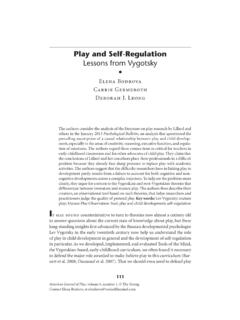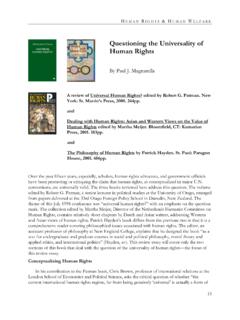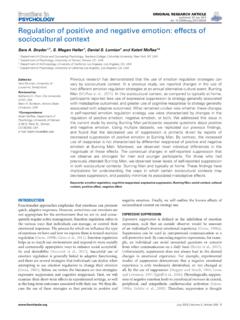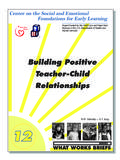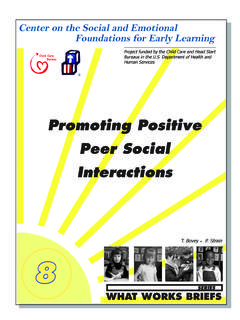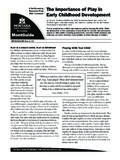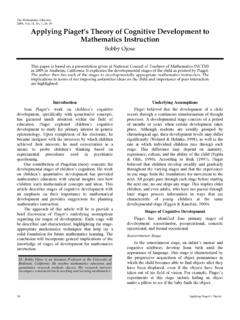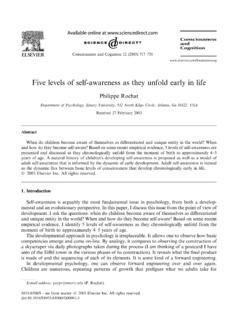Transcription of Developing young children's mathematical thinking and ...
1 See discussions, stats, and author profiles for this publication at: young children 's mathematicalthinking and understandingCHAPTER MARCH 2015 CITATION1 READS1012 AUTHORS:Douglas H. ClementsUniversity of Denver329 PUBLICATIONS 4,219 CITATIONS SEE PROFILEJ ulie SaramaUniversity of Denver166 PUBLICATIONS 1,730 CITATIONS SEE PROFILEA vailable from: Douglas H. ClementsRetrieved on: 26 January 2016t I I 28 Developing young children 'S mathematical thinking AND UNDERSTANDING Douglas H. Clements and Julie Sarama Introduction In contrast to the view that nuthcrnatics for very young children is developmentally inappropriate and that only simple number tasks are appropriate for the prirnary grades (see Balfwz, 1999; Hughes, 1986; Sun Lee and Ginsburg, 2009), research has shown that young children can think and underst;md mathcrmtics content th:1t is surprisingly broJd and deep.
2 Recent research and developmental work has suggested that leamil~:< trajerton'cs can help early childhood educators respect children 's develop -mental processes and constraints, and their potential fix thinking about and under-standing mathematical ideas (Bobis et al., 2005; Clarke, 2008; Clements and Sarama, 2009; Sar,nm and Clements, 2009b; Wright, 2003). in this chapter we briefly discuss young children 's natural mathematical thinking . Then, we give two concrete of learning trajectories, illustnting how they can be used to enhance teaching and learning. young children 's natural mathematical thinking It seems probable that little is gained by using any of the child's time for arith-metic before grade 2, though there are many arithmetic flcts dut he [sic] can learn in grade 1.
3 (Thorndike, 1922, p. 198) children have their own preschool arithmetic, which only myopic psychologists could ignore. !VxRotsky, 193511978, p. 84) 33! Doug/us I!. Clements arul julie Snmma For more than 100 years, vi('\VS of young children 's mathematics lnve dif-fered vvidciy, as tl1tse contradictory quotes hom two psychologists sbmv. Across that time, many have reponed observations of children enjoying pre- mathematical activities. However, others have expressed fears of the iruppropriatcness of mathemJtics f()r young cbildrcn, ;ilthough these opinions are based on broad social theories or trends. not obscrv:ttion (Balf:mz, 1999). The institutionalization of early dJildhood. edw:a -tion often extinguished prormsi11!; nl:ttllcnuticll movements. Consider Edward Thorndike, quoted above.
4 L-Ie \Vished to emphasize lwalth, rcpbccd the first: gift ofFroebcl's giti:s (rnanipuLnives, which were small spheres) with a toothbruslJ and the i-lr:sr JlJatheJuariol occupario11 with 'sleep' (Hrosrennan, 1 0')7). Similarly, .~omc argue cllildrcn :should be playing vv ith building blocks, rather than le:tming mathematics. But tbc origin:ll inventor, Caroline Pratt (194g), created toclay's unit blocks to reach mathematics! She tells of children making enough room f()r a horse ro fir inside a stable. Tht' teacher told Diam th~tt she could have the horse when she h:1d llLJde a sublc for it. Dian:1 and Elizabeth bcg;m to build a SllJall con-struction, but the horse did not fit. Diana had made a large stable with a rooC After several unsuccessful ;lttcmpts to gcr the horse in, she removed the roof, added blocks to the w:1lls ro make the roof higher, ami rcpbccd the roof She then tried to put into words vvhat she had done.
5 'Roof too smJJl.' The tc;Jcher gave her new words, 'high' and 'lovv-', and she gave a ne\.v exphnarion to the other children . Just building \Vith blocks, children form important ideas. 'Ic~H:her:; such as Diana's bclp children explicate and fun:hcr develop these intuitive ideas by discussing thelll, giving language to their actions. Like Pratt, we bdicve that 'doing mathcmdtics' is natural and appropriate fix chil-ciren of all ages-i( engendered :md supported wclJ. First, to he educative (Dewey. 193S/1997), m:lthematical experiences should involve rnathcmaticaJ procc~ses or practiL es such as problem-solving, lT<lsoning, connnunicating, modeling, and con-necting (discussion of these in depth is b(~yond the scope of this chapter, but the rcfi.:r-ences contain m_any clabor:1tions :mcl cx<unplcs).))
6 That is, every educative experience should involve hdping children mathcmatize (De Lange, 1YS7; Kaartincn and KurnpulaiJlcn, 2012) thL'ir world: n'prcsenting :mel claboratiJJg their world n1atlJcn l<l rically creating models of everyday situations with m;Jthcmatical ohjcrts. such as nurnbers and shapes; with llWthemarical actions, such :1s nnmting or trans-forming shapes; and with strurtura! rclarionships, such as 'one more' or 'cquaJ length'-and using those rnodels to solve problems. Second, to avoid being miscducative (J )cwey, 1 1J3B/ 1907), experiences shouid not ill elude imppropriatc and rou-tines, such as flash cards and timed tests to promote 'memorization' or basic t:n~ts (especially hefmc thinking strategies are well established) (Henry and Brown, :2001-l) or dull calendar exercises in which one child performs routine actions while others pas-sively wait fi)r it to he over (National Research Council, 2009, note this are misedu-cltivc for self-regulation as well as mathematics competencies).
7 Third, to be educative, experiences should he but ::tchievable, generative of future learning, :md consistent with young children 's 'mtunl' \vays of thinking and lcaruing (Clements ct a!., 2004; Tnmdley, 200N). We bclicw research-based lcarnitz~; u~~fcctorics are fcw thJt experiences ue lllaximally eduotive. 332 Developing young children 's mathematical thinking and understanding Learning trajectories: paths for successful learning Why learning trajectories? children generally follow certain developmental paths in mathematics. When teachers understand the progression of levels of thinking along these paths, and sequence and individualize activities based on them, they can build eHCctive mathematics learning environments. Research has suggested learning trajectories are effective in this way (Clements Jnd Sararna, in press; Sararna and Clernents, 2009b).
8 Simihrly, several recent efforts have based their reports on learning trajectories ( Horne and , 2001; Nes, 2009). The National Research Council report on early m~1thematics (2009) is subtitled, 'Learning paths toward excellence and equity'. The Early Nm11cTacy REsearch Project (ENRP) in Victoria, Australia was built around using 'growth points' to inform planning and teaching ( Clarke, 200B; F- Iorne and Rowley, 2001; Perry et al., 2008). The authors of the Common Core (CCSSO/NCA, 201 0) started by writing learning trajectories for each rn<ljor topic. These were used to determine what tbe sequence would be and were 'cut' into grJde-level specific standards. Similar approacht~s :11T used in the New Zeahnd Numcr:lcy Development Project, the Victorian Early Numeracy Research Project and the Count Me In Too program in New South Wales, AustraliJ.
9 (Dobis er al., 2005) as well as Mathematics Recovery (Wright, 2003). Each learning trajectory as we define it has three parts: a goal, a developmental progression, and instructional activities (Sararna and Clements, 2009b). To develop a certain mathematical competence (the goal), children construct each level of think-ing in turn (the developmental progression), aided by tasks and teaching (instruc-tional activities) designed to build the mental actions-on--c)~jects that enable thinking at each higher level (Clements and Sarama, in press; Sarama and , 2009b). As an initial example, take the goal of measuring length, ~l common goal for rnath-ernatics ( MacDonald et al., 2012), but one that challenges children ( in the iteration of standard units, Nunes et al., 2009).
10 A typical goal is fi)r children to learn, by the end of second grade (ages 7~8 years), to rneasure the length of objects using appropriate tools, relate the size of the unit to the number of units, determine how much longer one object is than another, and so forth. That is the iong-~rangc goal. children develop through a series of levels of thinking as they achieve that goal; that is, as they learn the ide;1s and skills that constitute accurate and meaningfitl mea-surement of length. At each level, children can solve a new type of problem. These levels form a dctJeloprnental proy_rr:ssion (cf MacDonald and Lowrie, 2011; McDonough and Sullivan, 2011). The second column in Figure describes several levels of thinking in the counting learning tr<~ectory. includes the narne of each level, a description, and a brief concrete example of a behavior indicative of that level of thinking (the first, or leftmost, column is the approximate age Jt which children achieve each level of thinking .



